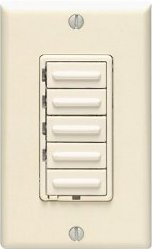You have decided to replace a wall light switch with a light dimmer, as shown in Figure 1. Whether it is for room ambience or to save energy, replacing a switch with a dimmer is not as simple as it may sound at the outset.

Figure 1 - Four level dimmer switch
While most basic home electrical switches are interchangeable, this is not the case with dimmers. As well, there are many different styles of dimmers and it is important that you choose one that will meet your needs and requirements.
This article is not designed to make you an expert in dimmer technology, after all, all you want to do is dim a light! What it should do is give you enough insight into the basic features and what you have to know before going shopping.
Light dimmers are basically designed for a maximum amount of load and that is a number given in watts and the type of bulb or lamp, incandescent, fluorescent, etc. Each manufacturer's also offers a variety of features that may or may not be of benefit in your specific situation.
Dimmer loads:
All dimmers are designed to handle a maximum amount or power or load and this is specified in watts. Determining your dimmer's wattage requirement is relatively simple.
- Count the number of bulbs or lamps that the dimmer is to control in the circuit.
- Determine the wattage of the bulbs or lamps in that specific circuit.
- Multiply the number of bulbs or lamps by the wattage.
As an example:
- You have 5 light fixtures in the circuit you wish to dim and each fixture has one bulb.
- You have 60 watt bulbs in each fixture.
- The wattage is 5 bulbs x 60 watts = 300 watt
So the minimum wattage of the dimmer you need is 300 watts.
The most common, maximum, wattage ratings for dimmers controlling incandescent light bulbs is 600, 1,000, 1,500 and 2,000 watts, based on a 120VAC nominal house electrical voltage.
As long as your wattage is less than the maximum rated wattage the dimmer will work. In this case you could use a 600, 1,000, 1,500 or 2,000 watt rated dimmer.
If the circuit had 7 bulbs and each bulb was a 100 watts you would require a dimmer that had a minimum load wattage of 700 watts (7 bulbs x 100 watts = 700 watts). In this case you could not use the dimmer that was only rated for 600 watts. Hence you would need to purchase a 1,000, 1,500 or 2,000 watt dimmer for this situation.
Note: If you currently have low wattage bulbs in the light fixtures and in the future you may want to increase the wattage, use the wattage number of the increased bulb size. As an example: You currently have 7 - 60 watt bulbs (420 watts), but you are considering changing them to 100 watt bulbs (700 watts), you should buy a dimmer that can handle the 700 watts not the 420 watts. If you do not, you will burn out the dimmer when you change from 60 watt bulbs to 100 watt bulbs.
Bulb and Lamp Types:
Once you have determined the total wattage that is going to be controlled by the dimmer you have to determine the type of lamp or bulb that you are planning on using.
Although a basic light switch will turn any electrical load "ON" and "OFF", dimmers are designed to dim specific types of loads.
Manufacturer's will specify the type of load that a specific dimmer is designed for.
Note: If load information is not provided do not buy that dimmer. There are no generic dimmers made that will control any type of load!
In North American home applications there are now 5 types of bulbs or lamps used:
- LED - now the most common bulb in North America as it draws very low power. However, you must purchase bulbs that are marked "dimmable" as not all LED bulbs can be controlled by dimmers.
- Incandescent - the old standard tried and true bulb that comes in many shapes, sizes and wattages.
- Halogen
- Fluorescent - fluorescent light bulbs require a ballast to turn them "ON". Most fluorescent light fixture ballasts will not work with dimmers. However, there are fluorescent light fixture ballasts that are designed specifically to be dimmed. It will state on the ballast if it is a "dimming" ballast. If you do have a "dimming" ballast in a fluorescent fixture that you wish to control with a dimmer you must purchase a dimmer that is specifically rated for controlling "dimming" fluorescent fixture ballasts.
- Compact Fluorescent Light Bulbs (CFL) - These types of light bulbs were becoming very popular because of their energy savings, but have now been been replaced by LED bulbs. They are basically fluorescent light bulbs made to replace standard incandescent bulbs and come in a variety of shapes and sizes. Dimmers and CFL bulbs are really not compatible and at the time of writing this article I do not recommend the use of dimmers with CFL bulbs. Although they seem to work in some cases, in other cases you will see flickering and it is not uncommon to have the light drop off sharply towards the low end of the dimmer's capability.
The most common dimmers will control both incandescent and halogen bulbs and lamps.
